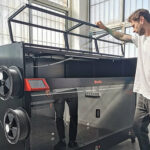It’s a sign of pride in the industry that 3D printed designs now adorn parks and museums across the world. So perhaps it’s time that companies would start breaking records in terms of scale and size by now. One such firm, Branch Technology, has done just that by printing the world’s largest 3D printed structure. The structure is a series of arches with 3 “legs” and triangular open spaces across its roof. It is currently available for viewing at Nashville, Tennessee’s OneC1TY neighborhood.
It’s worth noting that while the company is declaring this the largest structure, these are not official titles yet. At least not without a judge of some sort. However, it is nonetheless one of the largest structures and it is completely 3D printed, unlike many others. Still, it is a astonishing achievement and a very artful structure as well.
Dallas based developer Cambridge commissioned the piece originally, presenting it at the 2018 International Association for Shell and Spatial Structures just this week. The structure stands mighty at 20 feet tall and stretching 42 feet wide. Interestingly, it consists of ABS with reinforced carbon-fiber parts.
Branch Technology’s Cellular Fabrication
The original concept suggested the need for a steel support system but the following optimisations removed it. As a result, they were able to make it at a lower cost with far fewer headaches. R&D incubator CORE Studio helped them create an open-cell design for the structure. Both companies implemented Branch’s Cellular Fabrication technology, working through 40 different panels over the course of 10 weeks before coating it in a UV-protective paint.
Branch Technology is a start-up with a very particular vision in mind. While 3D printing the largest structure in the world is a goal on its own, the company also wanted to prove that their Cellular Fabrication methods are state of the art. Similarly, Branch Tech have been developing large pavilions across locations to showcase the benefits of their processes.
The process involves a robotic arm that extrudes carbon-fiber reinforced ABS plastic. The process has, so far, mostly been a way of making the inner scaffolding of walls from spray foam and concrete. However, the start-up has developed their own unique spin on it. The company ran through many design iterations, as you can see in the video above. Over the course of the process they eliminated any supports and arrived at the one above.
All images and video footage courtesy of Branch Technology.


